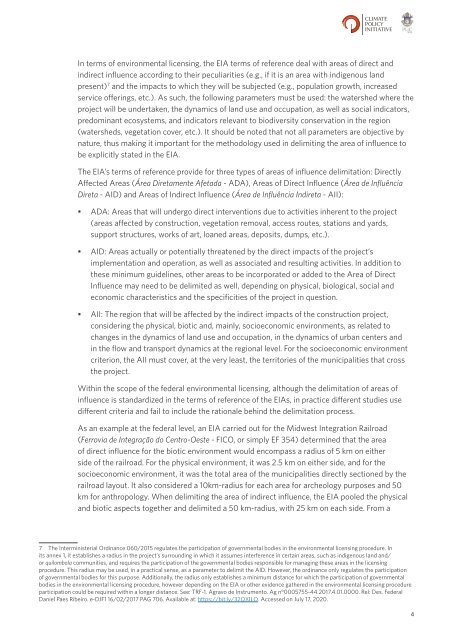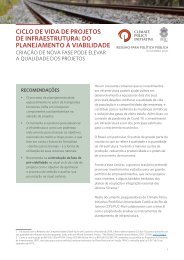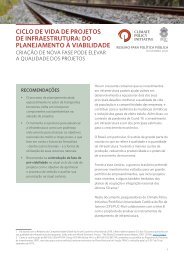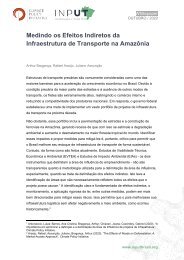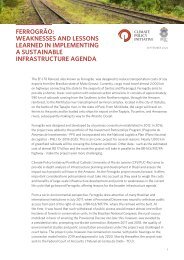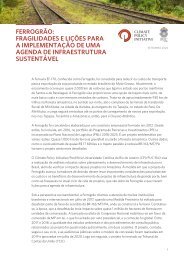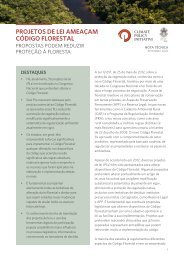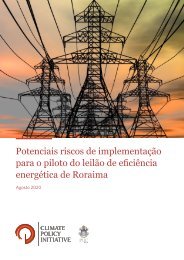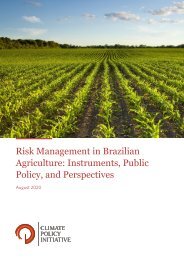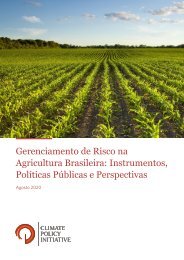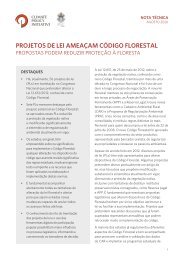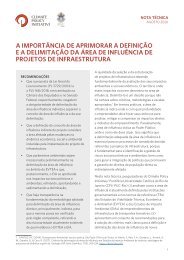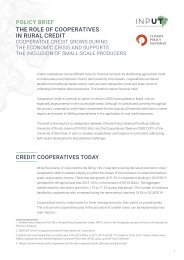The Need to Better Define and Delimit Area of Influence for Infrastructure Projects
You also want an ePaper? Increase the reach of your titles
YUMPU automatically turns print PDFs into web optimized ePapers that Google loves.
In terms <strong>of</strong> environmental licensing, the EIA terms <strong>of</strong> reference deal with areas <strong>of</strong> direct <strong>and</strong><br />
indirect influence according <strong>to</strong> their peculiarities (e.g., if it is an area with indigenous l<strong>and</strong><br />
present) 7 <strong>and</strong> the impacts <strong>to</strong> which they will be subjected (e.g., population growth, increased<br />
service <strong>of</strong>ferings, etc.). As such, the following parameters must be used: the watershed where the<br />
project will be undertaken, the dynamics <strong>of</strong> l<strong>and</strong> use <strong>and</strong> occupation, as well as social indica<strong>to</strong>rs,<br />
predominant ecosystems, <strong>and</strong> indica<strong>to</strong>rs relevant <strong>to</strong> biodiversity conservation in the region<br />
(watersheds, vegetation cover, etc.). It should be noted that not all parameters are objective by<br />
nature, thus making it important <strong>for</strong> the methodology used in delimiting the area <strong>of</strong> influence <strong>to</strong><br />
be explicitly stated in the EIA.<br />
<strong>The</strong> EIA’s terms <strong>of</strong> reference provide <strong>for</strong> three types <strong>of</strong> areas <strong>of</strong> influence delimitation: Directly<br />
Affected <strong>Area</strong>s (Área Diretamente Afetada - ADA), <strong>Area</strong>s <strong>of</strong> Direct <strong>Influence</strong> (Área de Influência<br />
Direta - AID) <strong>and</strong> <strong>Area</strong>s <strong>of</strong> Indirect <strong>Influence</strong> (Área de Influência Indireta - AII):<br />
• ADA: <strong>Area</strong>s that will undergo direct interventions due <strong>to</strong> activities inherent <strong>to</strong> the project<br />
(areas affected by construction, vegetation removal, access routes, stations <strong>and</strong> yards,<br />
support structures, works <strong>of</strong> art, loaned areas, deposits, dumps, etc.).<br />
• AID: <strong>Area</strong>s actually or potentially threatened by the direct impacts <strong>of</strong> the project’s<br />
implementation <strong>and</strong> operation, as well as associated <strong>and</strong> resulting activities. In addition <strong>to</strong><br />
these minimum guidelines, other areas <strong>to</strong> be incorporated or added <strong>to</strong> the <strong>Area</strong> <strong>of</strong> Direct<br />
<strong>Influence</strong> may need <strong>to</strong> be delimited as well, depending on physical, biological, social <strong>and</strong><br />
economic characteristics <strong>and</strong> the specificities <strong>of</strong> the project in question.<br />
• AII: <strong>The</strong> region that will be affected by the indirect impacts <strong>of</strong> the construction project,<br />
considering the physical, biotic <strong>and</strong>, mainly, socioeconomic environments, as related <strong>to</strong><br />
changes in the dynamics <strong>of</strong> l<strong>and</strong> use <strong>and</strong> occupation, in the dynamics <strong>of</strong> urban centers <strong>and</strong><br />
in the flow <strong>and</strong> transport dynamics at the regional level. For the socioeconomic environment<br />
criterion, the AII must cover, at the very least, the terri<strong>to</strong>ries <strong>of</strong> the municipalities that cross<br />
the project.<br />
Within the scope <strong>of</strong> the federal environmental licensing, although the delimitation <strong>of</strong> areas <strong>of</strong><br />
influence is st<strong>and</strong>ardized in the terms <strong>of</strong> reference <strong>of</strong> the EIAs, in practice different studies use<br />
different criteria <strong>and</strong> fail <strong>to</strong> include the rationale behind the delimitation process.<br />
As an example at the federal level, an EIA carried out <strong>for</strong> the Midwest Integration Railroad<br />
(Ferrovia de Integração do Centro-Oeste - FICO, or simply EF 354) determined that the area<br />
<strong>of</strong> direct influence <strong>for</strong> the biotic environment would encompass a radius <strong>of</strong> 5 km on either<br />
side <strong>of</strong> the railroad. For the physical environment, it was 2.5 km on either side, <strong>and</strong> <strong>for</strong> the<br />
socioeconomic environment, it was the <strong>to</strong>tal area <strong>of</strong> the municipalities directly sectioned by the<br />
railroad layout. It also considered a 10km-radius <strong>for</strong> each area <strong>for</strong> archeology purposes <strong>and</strong> 50<br />
km <strong>for</strong> anthropology. When delimiting the area <strong>of</strong> indirect influence, the EIA pooled the physical<br />
<strong>and</strong> biotic aspects <strong>to</strong>gether <strong>and</strong> delimited a 50 km-radius, with 25 km on each side. From a<br />
7 <strong>The</strong> Interministerial Ordinance 060/2015 regulates the participation <strong>of</strong> governmental bodies in the environmental licensing procedure. In<br />
its annex 1, it establishes a radius in the project’s surrounding in which it assumes interference in certain areas, such as indigenous l<strong>and</strong> <strong>and</strong>/<br />
or quilombola communities, <strong>and</strong> requires the participation <strong>of</strong> the governmental bodies responsible <strong>for</strong> managing these areas in the licensing<br />
procedure. This radius may be used, in a practical sense, as a parameter <strong>to</strong> delimit the AID. However, the ordinance only regulates the participation<br />
<strong>of</strong> governmental bodies <strong>for</strong> this purpose. Additionally, the radius only establishes a minimum distance <strong>for</strong> which the participation <strong>of</strong> governmental<br />
bodies in the environmental licensing procedure, however depending on the EIA or other evidence gathered in the environmental licensing procedure<br />
participation could be required within a longer distance. See: TRF-1. Agravo de Instrumen<strong>to</strong>. Ag n°0005755-44.2017.4.01.0000. Rel: Des. Federal<br />
Daniel Paes Ribeiro. e-DJF1 16/02/2017 PAG 706. Available at: https://bit.ly/32QXILO. Accessed on July 17, 2020.<br />
4


